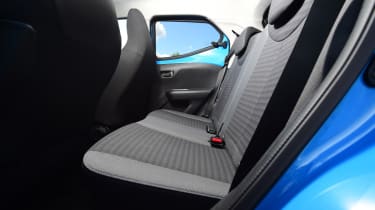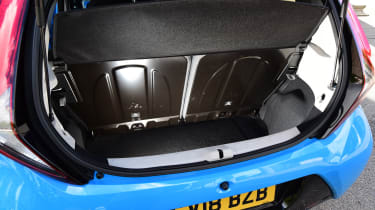Toyota Aygo (2014-2021) review - Practicality, comfort and boot space
The Aygo may have some space-age design cues, but it’s certainly no Tardis…

The Aygo is slightly longer, wider and lower than the Mk1, so looks a little less truncated from some angles, even though it has an identical wheelbase.
Only available as five-door model, the side glass design extends to meet the rear light clusters giving a sense of added length. Unfortunately it’s an illusion, and you shouldn’t be surprised to learn that rear seat passenger comfort is not a strength in the Aygo.
There are a pair of three-point seat-belts in the rear for adults, but no space for a third, while a pair of Isofix child seat mounts is standard in the back, too.
The news is better up front, where the driver sits relatively high up with a good view out. There’s a reasonable range of adjustment on the seat and steering wheel – although not quite enough for taller drivers, who may struggle to get comfortable.
There are two cup holders, a good-sized glovebox and door bins big enough to hold a 500ml bottle of water.
Size
The Aygo is a very compact car, so it's perfectly at home in the city where its dimensions make it a breeze to thread down side-streets and fit in even the smallest parking spaces.
More reviews
Car group tests
- Toyota Aygo vs Kia Picanto: a used cheap city car shootout
- Hyundai i10 vs Toyota Aygo vs Kia Picanto
- Suzuki Celerio vs Toyota Aygo & Skoda Citigo
In-depth reviews
Road tests
- New Toyota Aygo X 2022 review
- New Toyota Aygo 2018 review
- Toyota Aygo x-clusiv 2016 review
- Toyota Aygo X-pression x-wave review
Used car tests
It’s actually a few mm longer than the previous generation – 25 to be exact – but 5mm lower. The front and rear tracks have been widened by 8mm to improve the stance, and while the wheelbase is the same as before at 2,340mm, Toyota has still managed to find an extra 9mm of cabin space. It’s still a smidge shorter than a Hyundai i10, but the trade-off in lost practicality is evident the moment you need to carry passengers or put luggage in the boot.
Leg room, head room & passenger space
Front headroom has improved slightly, despite the lower roofline thanks to a curved ‘double-bubble’ roof and front seats lowered by 10mm. However, the small side windows at the back and high-backed front seats make the rear feel claustrophobic and legroom is seriously restricted even for smaller passengers. Rivals like the Hyundai i10 feel significantly roomier. The five-door model makes things easier for rear passengers to get in and out at least.
The £850 'x-wave' option brings an electrically retractable folding fabric roof that slides back to the rear headrests in around 10 seconds, or bunches up halfway to act as a sunroof. If you look below the roofline, however, the Aygo's lines – and more importantly its passenger accommodation - are unaffected.
Boot
The Aygo makes the most of its compact dimensions with a deep but narrow boot that’s 29 litres bigger than its predecessor's at 168 litres – it's just about enough for a couple of suitcases or a set of golf clubs.
It will be fine for many owners’ purposes, but if cargo capacity is your main consideration, the Aygo does lose out badly to the Hyundai i10 and VW Up, both of which offer capacities north of 250 litres.
The design isn’t ideal either as there’s a fairly high lip between the boot floor and your luggage, and the rear seats – with optional split fold – don’t even lie flat, instead leaving an awkward step.










